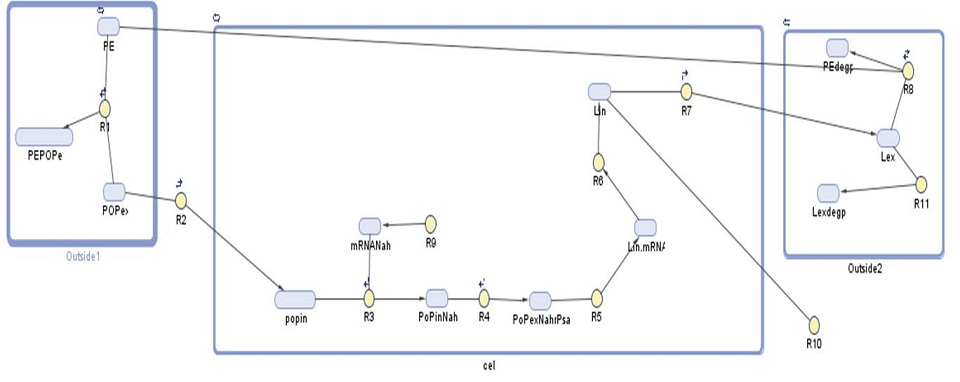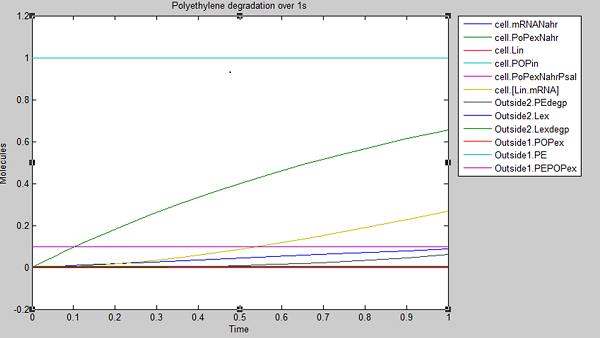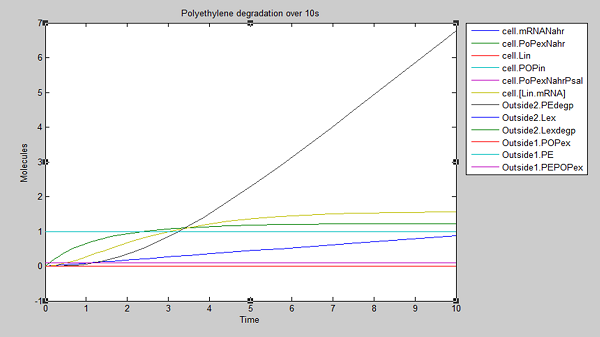Team:University College London/Module 3/Modelling
From 2012.igem.org
Erinoerton (Talk | contribs) (→Modelling) |
Erinoerton (Talk | contribs) (→Modelling) |
||
| Line 11: | Line 11: | ||
! Species!! Initial value (molecules) !! Notes | ! Species!! Initial value (molecules) !! Notes | ||
|- | |- | ||
| - | | PE|| 0. | + | | PE|| 0.044 || Polyethylene found in North Pacific Gyre per cubic metre<sup>1,2</sup> |
|- | |- | ||
| - | | | + | | POPex || 0.0 || Persistent organic pollutants (ex = extracellular) that are not adhered to plastic surface |
|- | |- | ||
| - | | PEPOPex || 9.24E-5 || | + | | PEPOPex || 9.24E-5 || Persistent organic pollutants (ex = extracellular) that are adhered to the plastic surface |
|- | |- | ||
| - | | POPin || 0.5 || | + | | POPin || 0.5 || Persistent organic pollutants (in = intracellular) |
|- | |- | ||
| - | | | + | | mRNANahR || 0.0|| NahR mRNA product |
|- | |- | ||
| - | | POPinNahR || 0.0|| | + | | POPinNahR || 0.0|| Complex of the above two molecules |
|- | |- | ||
| - | | Lin|| 0.0|| | + | | POPinNahRPsal || 0.0 || Complex of the above molecule and Psal (promoter that induces laccase transcription) |
| + | |- | ||
| + | | Lin|| 0.0 || Intracellular laccase | ||
| + | |- | ||
| + | | Lex || 0.0 || Extracellular laccase | ||
| + | |- | ||
| + | | LinmRNA || 0.0 || Laccase mRNA product | ||
| + | |- | ||
| + | | Ldegp || 0.0 || Laccase that degrades due to nonoptimal conditions and malformed laccase that cannot carry out polyethylene degradation | ||
| + | |- | ||
| + | | PEdegp || 0.0 || Polyethylene degraded by laccase | ||
|} | |} | ||
| Line 60: | Line 70: | ||
[[File:deg3.png]] comment here? | [[File:deg3.png]] comment here? | ||
| + | |||
| + | 1. Goldstein M, Rosenberg M, Cheng L (2012) Increased oceanic microplastic debris enhances oviposition in an endemic pelagic insect, <i>Biology Letters</i> 10.1098 | ||
| + | |||
| + | 2. Andrady AL (2011) Microplastics in the marine environment. <i>Marine Pollution Bulletin</i> 62: 1596-1605 | ||
1. Laccase size: http://partsregistry.org/Part:BBa_K729002 | 1. Laccase size: http://partsregistry.org/Part:BBa_K729002 | ||
Revision as of 10:28, 21 September 2012
Module 3: Degradation
Description | Design | Construction | Characterisation | Modelling | Results | Conclusions
Modelling
Our gene network model for this module shows the amount of laccase produced by our bacteria. We have used this prediction to find out how many bacteria would be required per cubic meter of sea water in order to effectively degrade polyethylene-based plastics.
| Species | Initial value (molecules) | Notes |
|---|---|---|
| PE | 0.044 | Polyethylene found in North Pacific Gyre per cubic metre1,2 |
| POPex | 0.0 | Persistent organic pollutants (ex = extracellular) that are not adhered to plastic surface |
| PEPOPex | 9.24E-5 | Persistent organic pollutants (ex = extracellular) that are adhered to the plastic surface |
| POPin | 0.5 | Persistent organic pollutants (in = intracellular) |
| mRNANahR | 0.0 | NahR mRNA product |
| POPinNahR | 0.0 | Complex of the above two molecules |
| POPinNahRPsal | 0.0 | Complex of the above molecule and Psal (promoter that induces laccase transcription) |
| Lin | 0.0 | Intracellular laccase |
| Lex | 0.0 | Extracellular laccase |
| LinmRNA | 0.0 | Laccase mRNA product |
| Ldegp | 0.0 | Laccase that degrades due to nonoptimal conditions and malformed laccase that cannot carry out polyethylene degradation |
| PEdegp | 0.0 | Polyethylene degraded by laccase |
| Number | Reaction | Reaction rate (molecules/sec) | Notes |
|---|---|---|---|
| R1 | PE + POPex ↔ PEPOPex | Forward: 1000 Backward: 1 | Pops have 1000 times greater tendency to adhere to plastic than float free in the ocean |
| R2 | POPex ↔ POPin | Forward: 0.6 Backward: 0.4 | Based on membrane permeability: diffusion gradient |
| R3 | POPin + mRNA.Nahr → POPin.mRNA.Nahr | Forward: 1 Backward: 0.0001 | The chemical structure/size of POPs is similar to salycilate which is the original compound that react to mRNA.Nahr -> 0 (??) |
| R9 | 0 → mRNA.Nahr | Forward: 0.088 Backward: 0.6 | Transcription rate of NahR in molecules/sec (for NahR size 909 bp2, transcription rate in E.coli 80bp/sec) |
| R4 | POPinmRNANahr → POPinmRNANahr.Psal | Forward: 78200 Backward: 0.191 | |
| R5 | POPexmRNANahr.Psal → Lin.mRNA | 0.054 | Transcription rate of Laccase in molecules/sec (for laccase size 1500 bp1, transcription rate in E.coli 80bp/sec) |
| R6 | Lin.mRNA → Lin | 0.04 | Translation rate of Laccase in molecules/sec (for laccase size 500 aa, translation rate in E.coli 20aa/sec) |
| R11 | Lin → Lindegp | 0.03 | |
| R7 | Lin → Lex | Forward: 0.9 Backward: 0.1 | |
| R8 | Lex → PEdegp | Vm: 0.01 Km: 0.114 |
We ran three simulations in SimBiology, each over a different timespan:
1. Goldstein M, Rosenberg M, Cheng L (2012) Increased oceanic microplastic debris enhances oviposition in an endemic pelagic insect, Biology Letters 10.1098
2. Andrady AL (2011) Microplastics in the marine environment. Marine Pollution Bulletin 62: 1596-1605
1. Laccase size: http://partsregistry.org/Part:BBa_K729002
2. NahR size: http://www.xbase.ac.uk/genome/azoarcus-sp-bh72/NC_008702/azo2419;nahR1/viewer
3. Mato Y, Isobe T, Takada H, Kanehiro H, Ohtake C, Kaminuma T (2001) Plastic Resin Pellets as a Transport Medium for Toxic Chemicals in the Marine Environment. Environ. Sci. Technol. 35: 318-324
4. Teuten E, Saquing J, Knappe D et al. (2009) Transport and release of chemicals from plastics to the environment and to wildlife. Philosophical transactions of the Royal Society of London 364: 2027-2045
8. Young K, Silver LL (1991) Leakage of periplasmic enzymes from envA1 strains of Escherichia coli. J Bacteriol. 173: 3609–3614
11.Van A, Rochman C, Flores E, Hill K, Vargas E, Vargas S, Hoh E (2012) Persistent organic pollutants in plastic marine debris found on beaches in San Diego, California. Chemosphere 86: 258-263
12. Santo M, Weitsman R, Sivan A (2012) The role of the copper-binding enzyme - laccase - in the biodegradation of polyethylene by the actinomycete Rhodococcus ruber. International Biodeterioration & Biodegradation 208: 1-7
POPS & PLASTIC QUANTITITES
Rios L, Moore C, Jones P (2007) Persistent organic pollutants carried by synthetic polymers in the ocean environment. Marine Pollution Bulletin 54: 1230–1237
Takada H, et al (2010) Global distribution of organic micropollutants in marine plastics. Report to Algalita Marine Research Institute
Heskett M, Takada H, Yamashita R, Yuyama M, Ito M, Geok YB, Ogata Y, Kwan C, Heckhausen A, Taylor H, Powell T, Morishige C, Young D, Patterson H, Robertson B, Bailey E, Mermoz J (2012) Measurement of persistent organic pollutants (POPs) in plastic resin pellets from remote islands: Toward establishment of background concentrations for International Pellet Watch. Marine Pollution Bulletin 64: 445-448
4. SALYCITATE
Park H, Lim W, Shin H (2005) In vitro binding of purified NahR regulatory protein with promoter Psal. Biochimica et Biophysica Acta 1775: 247-255
5. LACCASE
Ding Z, Peng L, Chen Y, Zhang L, Gu Z, Shi G, Zhang K (2012) Production and characterization of thermostable laccase from the mushroom, Ganoderma lucidum, using submerged fermentation. African Journal of Microbiology Research 6: 1147-1157. DOI: 10.5897/AJMR11.1257
6 Kunamneni A, Plou FJ, Ballesteros A, and Alcalde M. Laccases and their applications: A patent review. Departamento de Biocatálisis, Instituto de Catálisis y Petroleoquímica, CSIC, Cantoblanco, 28049 Madrid, Spain.
7. BRENDA: EC 1.10.3.2 – laccase
8. E.COLI MEMBRANE PERMEABILITY
Heskett M, Takada H, Yamashita R, Yuyama M, Ito M, Geok YB, Ogata Y, Kwan C, Heckhausen A, Taylor H, Powell T, Morishige C, Young D, Patterson H, Robertson B, Bailey E, Mermoz J (2012) Measurement of persistent organic pollutants (POPs) in plastic resin pellets from remote islands: Toward establishment of background concentrations for International Pellet Watch. Marine Pollution Bulletin 64: 445-448 is this right? This is what’s on excel
7. DIFFERENT REGULATOR SYSTEMS Wang B, Papamichail D, Mueller S, Skiena S (2007) Two Proteins for the Price of One: The Design of Maximally Compressed Coding Sequences. DOI: 10.1.1.174.6416
 "
"



